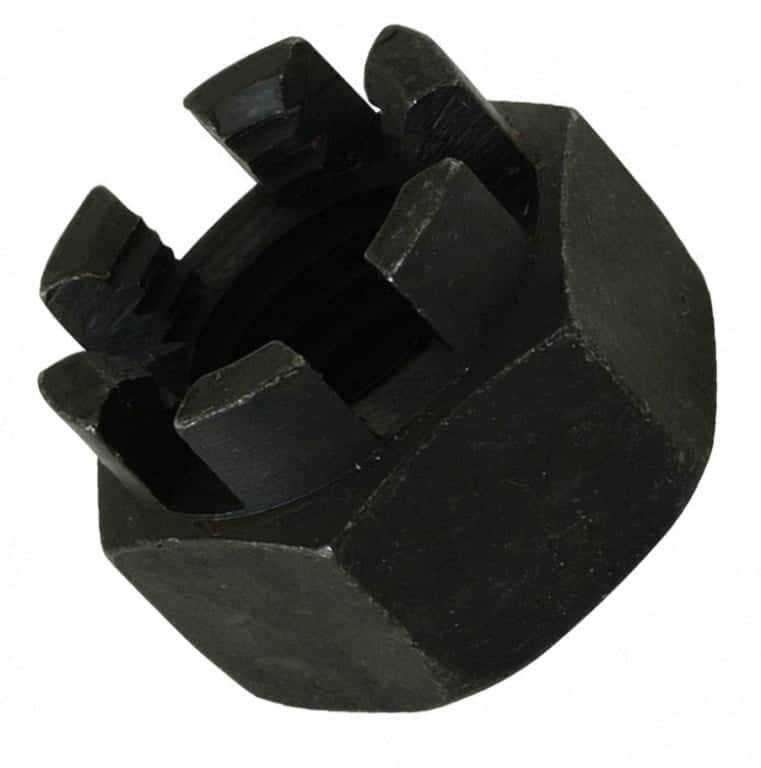Product Code DIN935-1
Dinstock are suppliers of a range of slotted nuts including Castle Nuts.
A castellated nut also called a castle nut or slotted nut, is a nut with slots (notches) cut into one end. The name comes from the nut’s resemblance to the crenelated parapet of a medieval castle.
The bolt or axle has one or two holes drilled through its threaded end. The nut is torqued properly and then if the slot isn’t aligned with the hole in the fastener, the nut is rotated to the nearest slot. The nut is then secured with a cotter pin or safety wire.
Castellated nuts are used in low-torque applications, such as holding a wheel bearing in place.
What is the difference between castle nuts and slotted nuts?
Both a castle nut and a slotted nut are very similar. They’re often used interchangeably because they’re almost identical in dimensions.
However, they are different in that the protrusions on a slotted nut are from the base of the nut and include the corners, whereas a castle nut looks like a standard nut with triangular portions protruding, but not including the corners of the hex.
When a slotted nut is used in the application, a bolt or threaded bar usually has a pre-drilled hole so that when the slotted nut is threaded on and torqued to the required position, it can be then secured using a cotter pin or write to prevent rotation.
A slotted nut has slots cut into one end of the nut.
Slotted nuts are used in applications where motion or vibration might undo the locknut.
Slotted nuts are usually manufactured as standard from steel grade 4, 8, and 10, and A2 and A4 stainless steel.
A range of sizes, thread styles, and finishes are available.
Uses for Castle Nuts and Slotted Nuts
Castle Nuts
Castle nuts, also known as castellated nuts, are designed with notches or slots cut into their top, resembling the crenellated towers of a medieval castle. These nuts are commonly used in applications where secure fastening is essential, and where the nut must be locked in place to prevent movement.
Typical Uses:
- Low-Torque Applications: Castle nuts are often employed in low-torque settings, such as in securing wheel bearings, where a high level of precision and stability is required.
- Automotive and Machinery: They are frequently used in automotive and machinery assemblies where vibrations or rotational forces might otherwise loosen the fastener.
- Safety: By allowing for the use of a cotter pin or safety wire, castle nuts help ensure that the nut remains securely in place even under demanding conditions.
Advantages:
- Stability: Provides a stable connection by allowing for the use of additional locking mechanisms.
- Alignment: Ensures that the nut can be aligned with holes or slots in the bolt or axle, enhancing overall safety.
Slotted Nuts
Slotted nuts, while similar to castle nuts, have a slightly different design. They feature slots cut into one end of the nut, which can also be used to lock the nut in place with a cotter pin or wire.
Typical Uses:
- Applications with Vibration: Slotted nuts are well-suited for applications where vibration or movement could potentially loosen the nut. They are commonly used in machinery and equipment where reliable fastening is crucial.
- Securing Moving Parts: They are often employed to secure parts that experience regular motion or stress, helping to maintain their integrity over time.
Advantages:
- Versatility: Suitable for a wide range of applications, including those where motion might otherwise undo a conventional nut.
- Pre-Drilled Bolts: Typically used with bolts or threaded rods that have pre-drilled holes, ensuring that the nut can be locked securely in place.
Comparison:
Although castle nuts and slotted nuts are similar and sometimes used interchangeably, their primary difference lies in the design of the slots and their specific application advantages. Castle nuts feature triangular notches and are often used in situations requiring high stability. Slotted nuts, on the other hand, may offer a more general locking solution where motion or vibration is a concern.
Both types of nuts are available in various materials, including steel grades and stainless steel, to suit different environmental and performance requirements. Understanding the specific needs of your application will help in choosing the appropriate type of nut for the job.



